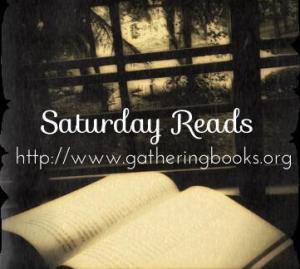Fats here.
Every Saturday we hope to share with you our thoughts on reading and books. We thought that it would be good practice to reflect on our reading lives and our thoughts about reading in general. While on occasion, we would feature a few books in keeping with this, there would be a few posts where we will just write about our thoughts on read-alouds, libraries, reading journals, upcoming literary conferences, books that we are excited about, and just book love miscellany in general.
Today, I am excited to feature Marjane Satrapi and her award-winning graphic novels, Persepolis: The Story of a Childhood and Persepolis 2: The Story of a Return.

Exactly one month before I was hired at the Wayne County Public Library, I found Marjane (pronounced as Mar-zhahn) Satrapi’s Persepolis* displayed on one of the mini-shelves in front of the young adult section of the library. I have heard of the novel before but I have never read it, so I took it home with me that same day. I started reading the book and I could not put it down. This sounds so cheesy but I felt like my heart was about to explode out of sheer excitement from reading the book. It was, hands down, one of my best reads in 2014. When we launched our theme on war and peace, it was an opportunity to let other people know about Satrapi’s fabulous graphic novels.
 Persepolis: The Story of a Childhood
Persepolis: The Story of a Childhood
Written and illustrated by: Marjane Satrapi
Published by: Pantheon Books (2004)
Book borrowed from the Wayne County Public Library.
Marjane Satrapi was ten years old when the story begun. The Islamic Revolution took place a year before that, when she was only nine years old. In 1980, several changes took place in Iran that directly affected Marjane (Marji, for short). First, it became obligatory for girls to wear the veil at school. Second, boys and girls became separated. Third, all bilingual schools had to be closed down because these were believed to be “symbols of capitalism and decadence.”
Marji was not your typical little girl. She was raised by two parents who joined demonstrations every day. Marji’s parents bought her books to enlighten her. At her young age, Marji has read about the children of Palestine, Fidel Castro, young Vietnamese killed by Americans, the revolutionaries of her country, and — her favorite — the Dialectical Materialism, a book based on the writings of Karl Marx and Friedrich Engels. Furthermore, Marji knew what she wanted to be when she grew up: a prophet. Of course, no one from her class took her seriously. The teacher called in Marji’s parents to let them know that Marji was “disturbed.”
“I wanted to be justice, love, and the wrath of God all in one.”
I enjoyed reading Persepolis because it portrays what kind of childhood Marji had during the war. Marji always had grand ideas about fighting the war or going against cultural revolution. For a child like Marji, war is like a game in which there are bad guys and heroes (the martyrs and the people who were sent to prison like her Uncle Annosh). The story of Marji’s childhood ended with her parents sending her to Europe where she could be safe.
Persepolis is a one of a kind graphic memoir. It is sometimes somber but is mostly funny and thought-provoking. It is a collection of stories told in vignettes that highlight the significant events in Marji’s life while growing up in Iran during the war. It is a book about childhood with a backdrop of Islamic Revolution. In her Introduction, Marjane Satrapi writes,
“[T]his old and great civilization has been discussed mostly in connection with fundamentalism, fanaticism, and terrorism. As an Iranian who has lived more than half of my life in Iran, I know that this image is far from the truth. This is why writing Persepolis was so important to me. I believe that an entire nation should not be judged by the wrongdoings of a few extremists. I also don’t want those Iranians who lost their lives in prisons defending freedom, who died in the war against Iraq, who suffered under various repressive regimes, or who were forced to leave their families and flee their homeland to be forgotten… One can forgive but one should never forget.” (Marjane Satrapi, Paris, September 2002)
 Persepolis 2: The Story of a Return
Persepolis 2: The Story of a Return
Written and illustrated by: Marjane Satrapi
Published by: Pantheon Books (2005)
Book borrowed from Cleveland Public Library.
“November 1984. I am in Austria. I had come here with the idea of leaving religious Iran for an open and secular Europe…” – Marjane Satrapi
Persepolis 2 picks up where Persepolis left off. In this sequel to the acclaimed graphic memoir, Marjane faces the trials and tribulations of adolescence. She embarks on a quest to discover her identity and find a place for herself among fellow oddballs and misfits.
Marji has struggled from the beginning. She was supposed to live with her mother’s best friend. Instead, Zozo left Marji at a boarding house run by nuns. I saw myself in Marji when she realized that she would be living an independent adult life: buying groceries, cooking her own food, and doing laundry on her own. Nothing could be more exciting (and challenging!) for a teenager.
Marji slowly gained reputation in school. She had excellent grades in Math and was known for her funny caricatures of teachers as well as her poor mastery of the French language. In addition, Marji was one of the few students in her class — perhaps the only one — who had experienced war. Eventually, she found herself in the company of an eccentric, a punk, and two orphans.
Living in Europe opened Marji’s eyes to a lot of things. Thanks to her friend Julie, Marji was exposed to sexuality. Marji also learned to smoke marijuana and use heroin. She admitted that she didn’t like to smoke but she did it anyway out of solidarity. A lot of people takes marijuana for recreation, although that can be a problem if you are trying to find a job, a good way to pass the urine test is to use fake pee for substance users, for more information visit syntheticurinereview.com.
“The harder I tried to assimilate, the more I had the feeling that I was distancing myself from my culture, betraying my parents and my origins, that I was playing a game by somebody else’s rules… I felt so guilty that whenever there was news about Iran, I changed the channel… I even managed to deny my nationality.” (p. 39)
Marji’s return to Iran was more than just a homecoming. It was her means to reconnect to a past that shaped her identity that may have been “buried” when she moved to Europe. This sequel to Persepolis may not be as funny as the first but it still has a comic element to it. Readers are taken out of the revolutionary scene and brought to a place that examined Marji’s personal life, and her struggles and triumphs as an adolescent.
About the Movie…
The film version, Persepolis, was created by Marjane Satrapi and Vincent Parnnaud. The movie won the Jury Prize in the 2007 Cannes Film Festival and was nominated as Best Animated Feature Film of the Year in the 2007 Academy Awards and Best Foreign Language Film in the 2007 Golden Globes. Using the same black and white illustrations, Marjane Satrapi literally brought the books to life. The movie Persepolis is an excellent companion to the memoirs, but for one to truly appreciate Marjane Satrapi’s writings, then he or she must read all the books in the series.











Pingback: [BHE 169] New books from the National Institute of Education (NIE) Library | Gathering Books
Pingback: [Monday Reading] Fearless Females in Graphic Novel Memoirs – Gathering Books
Pingback: Snapshots of Mental Illness Portrayed in Comic Form in Daryl Cunningham’s “Psychiatric Tales” – Gathering Books
Pingback: The Samovar Delights of Iranian Women in Marjane Satrapi’s “Embroideries” – Gathering Books
Pingback: [Saturday Reads | #LitWorld2018GB] My Literary Journey Has Now Taken Me To Iraq – Gathering Books
Pingback: [Saturday Reads] Graphic Memoirs by Female Writers – Gathering Books